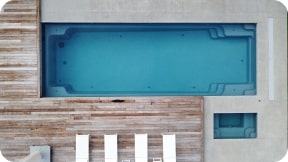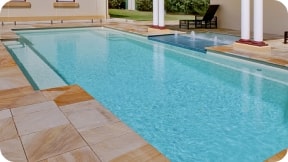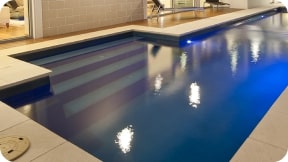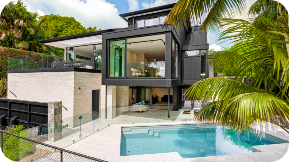Articles
How much does a swimming pool cost?
What does it cost for an in-ground pool?
Naturally one of the first questions people ask us is “what will my new in-ground pool cost?” To answer this question we'll look at things from two different perspectives.
- Building and getting your pool up and running.
- Ongoing maintenance and upkeep costs.
Cost Area 1: Building and getting your in-ground pool up and running.
First let’s look at the different types of pools there are to choose from. In New Zealand the most common types of pool are fibreglass, concrete and vinyl liners. As you can imagine not all pools are created equal and for that reason the costs vary between them.
The cost of installing a fibreglass pool
Some fibreglass pool companies offer DIY pool kits you can buy and install yourself with the incentive of saving you some money. While your DIY pool kit might only cost you around $15,000, it’s important to understand the additional installation costs you’ll face on top of that, not to mention the associated risks and other hidden costs of installing your own pool. Most people find having a professional pool builder supply and install their pool is more cost-effective, it’s less hassle and gives them peace of mind that it’s safe and secure.The price range for getting your new fibreglass pool installed by a pool builder starts at around $50,000 for a smaller pool and can cost anywhere up to $95,000 for larger pools plus extras. I know – that’s a pretty big price range. The factors that influence the cost of your pool mostly come down to personal preferences, the conditions of your pool site, and the technology of the pool shell (which depends on the manufacturer), but here are a few things that will alter the cost:
- Access to your pool site
- Condition of the soil
- The size of pool you choose
- How you set your pool up to suit your lifestyle (e.g. do you need a superior circulation and cleaning system)
- Any additional water or lighting features you add to enhance the look of your new in-ground pool
- The quality of product you opt for, including the pool shell manufacturing method
The quality of manufacturing and the end-product is pretty high these days, but naturally not all fibreglass pools are the same, so it pays to make sure you’re comparing apples with apples. For example there are substantial differences between a traditional fibreglass pool and a fibreglass ceramic pool. When looking at a pool, narrow down the main benefits it offers, identify if there are any features it has that other pools don’t have? What sort of operating system does it come with (e.g. traditional filtration only, enhanced circulation, or superior in-floor cleaning)? What warranties and guarantees are provided, is there any ongoing protection offered?
You’re also going to be interested in how long it takes to build your new pool and when it will be ready to swim in. Choosing a fibreglass pool, as opposed to a concrete pool, means your pool can be installed within a number of days, rather than months. For more information about how long it takes to build a new pool click here.
BROWSE POOL SHAPES
The cost of installing a vinyl-liner pool
Some buyers prefer to go with a prefabricated above-ground vinyl-liner pool, perhaps because the initial install costs are lower than other options. In-ground vinyl-liner pools can be installed professionally for around the same cost as a fibreglass pool, however this type of pool is less popular in New Zealand than a fibreglass or concrete pool.There is an option for you to get a DIY kit for an in-ground vinyl-liner pool, which is only around $10,000, but keep in mind that price doesn’t include any extra installation costs – the installation method for this type of pool will affect the cost of the installation, for example most in-ground vinyl-liner pools need a concrete floor poured first. If a DIY pool is the way you want to go just make sure you investigate all the construction requirements and the extra associated costs involved (additional contractors are normally needed for any excavation and concrete work). And remember that vinyl-liner pools are going to have higher ongoing maintenance costs and care requirements than a concrete or fibreglass pool. Keep reading for more on maintenance and care costs of your pool.
The cost of building a concrete pool
It’s a bit harder to give you an idea of the costs involved when building a concrete pool, in large part because the choice of size and shape isn’t restricted to a range of set designs like with a fibreglass pool – you have the freedom to pick the exact shape and size that suits your home and lifestyle. But generally the price of a concrete pool starts at a similar price to a fibreglass pool, but the upper limit can be much higher.If you’re thinking that a concrete pool is going to be stronger and more durable than a fibreglass pool, well you’ll be surprised to know that might not be the case, there have been some huge advances with fibreglass technology. In fact, the strength and durability of most fibreglass pools means they now come with warranties that match or surpass that of a concrete pool. The Compass Pools range of Bi-luminite Fibreglass Ceramic pools come with a lifetime structural warranty. So if you’re the original owner that warranty will last the entire lifetime you are at that property, and if you move it can be transferred to a new owner in the first 25 years.
Cost Area 2: Ongoing maintenance and upkeep costs.
No matter what type of pool you choose you will have to maintain a certain level of care and maintenance to ensure it remains clean and healthy, and can withstand the elements. How you set your pool up from the get-go can quite significantly affect the ongoing costs.There are 5 key factors that are going to influence the ongoing costs of your pool:
- How the water is filtered (running and servicing your pumps and filters)
- How the water is sanitised (costs of chemicals, salt water chlorinators)
- How your pool is cleaned (robot cleaners, self-cleaning units, suction cleaners)
- Keeping your pool looking like new (maintaining aesthetics)
- How you use your pool (heat-pumps, water features)
The ongoing costs of having a concrete pool
Concrete pools need more ongoing attention than fibreglass pools, this is because of the porous nature of the concrete, it provides an ideal breeding environment for algae and bacteria. So that means you’ll need to spend more time cleaning, and spend more money on chemicals, to make sure your pool stays healthy and safe to swim in. Because concrete is more porous and doesn’t have a smooth surface the same as fibreglass does, it is more prone to attracting black algae which often proves expensive and difficult to get rid of.It’s also important to note that concrete pools require regular aesthetic maintenance. Every three to five years a concrete pool normally needs to be acid-washed, and every ten to fifteen years it’s quite standard to re-plaster or resurface the pool. These add a substantial amount to the ongoing running costs of your pool.
The ongoing costs of having a vinyl-lined pool
In comparison with a fibreglass pool a vinyl-liner pool (also known as a vinyl-lined pool) requires more maintenance and attention. You might expect that vinyl-lined pools are more susceptible to punctures from sharp objects, and you’d be right, so you need to allow for repair work should that happen. The vinyl pool liner normally has a life expectancy of five to ten years, so throughout a ten year period you should expect to replace the vinyl-liner at least once. For an average sized pool you’re looking at over $4,000 for a good quality liner.
The ongoing costs of having a fibreglass pool
A fibreglass pool doesn’t require you to spend a lot of time, effort or money with ongoing maintenance. In fact, once it’s in the ground there isn’t much you have to do at all, the same can’t be said for a concrete or vinyl-liner pool. And providing you follow the manufacturer’s recommended guidelines and maintain stable water conditions and the right levels of chlorine all year round, you shouldn’t need to re-coat or resurface your fibreglass pool. Here at Compass, we do recommend that you hand-polish the gelcoat surface (just the bit above the waterline) from time to time.This gelcoat surface is smooth (unlike most concrete surfaces) which makes it difficult for bacteria and algae to grow. So as a result you don’t need to use as many chemicals and you might even be able to cut down the amount of time you run your filtration system for – which also means you’ll spend less money on power.
The Compass Vantage self-cleaning and circulation system is a great system to add to your Compass fibreglass ceramic pool. The good news is it will save you a considerable amount of money on chemicals, cleaning equipment and power. And even better, you won’t need manual or robotic cleaners. How it works is by improving the circulation in your pool making it hard for bacteria and algae to grow and spread.
One last piece of advice about comparing pool prices...
It’s important to consider the future when you’re looking at investing in a pool, and in particular when you come to sell your home, will you be able to get that initial investment back or even build on it?
Buyers in the real estate market can be summed up in two categories, they either like the idea of having a pool or they’re a bit wary about it. Most people that are wary of having a pool are worried about the pool constantly taking up their time and needing a lot of upkeep or having to pay someone else to do it for them.
Having a fibreglass pool means the effort and cost of owning and maintaining a pool are minimal. And a fibreglass ceramic pool from Compass with Vantage makes life even easier, it’s practically hands-free pool care.
It’s a wise move to consider the future when you’re choosing the pool that best suits your needs, because when the day comes to sell your home, you’ll want your pool to add value and be an attractive feature for prospective buyers, not a cause for concern or apprehension.
The reality is, when you get a pool there is more involved than just the price of the pool. Sometimes the pools with smaller upfront price tags actually end up costing more in the long run (e.g. DIY pool kits with unknown install costs and associated risks). On the other hand, pools which can end up being more expensive don’t always deliver the amount of value you’d expect to get from paying extra.
Read more articles























.png)




